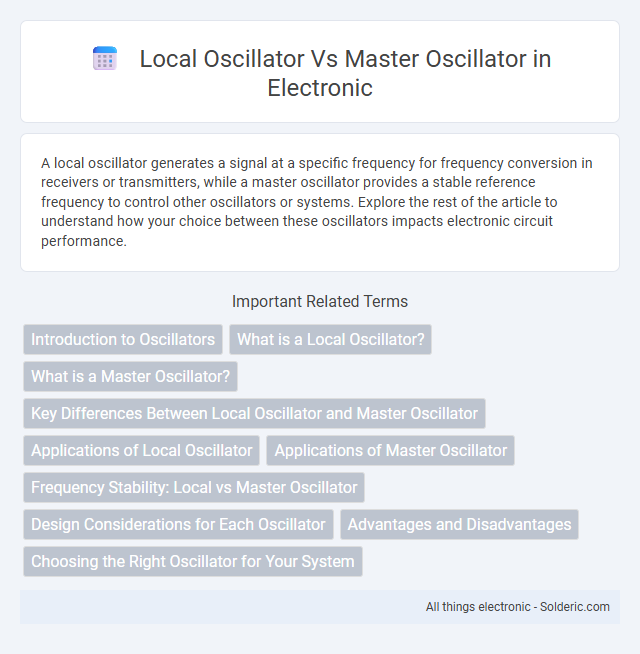A local oscillator generates a signal at a specific frequency for frequency conversion in receivers or transmitters, while a master oscillator provides a stable reference frequency to control other oscillators or systems. Explore the rest of the article to understand how your choice between these oscillators impacts electronic circuit performance.
Comparison Table
| Feature | Local Oscillator | Master Oscillator |
|---|---|---|
| Purpose | Generates frequency for signal mixing or modulation within a device | Provides stable reference frequency to control multiple oscillators |
| Frequency Stability | Moderate, depends on design and temperature | High, precision-controlled for system synchronization |
| Role in System | Acts locally for frequency conversion or generation | Serves as the primary frequency reference source |
| Applications | Radio receivers, mixers, signal converters | Communication systems, synchronized networks, radar |
| Control | Typically independently controlled per module | Centralized control for multiple dependent oscillators |
| Output | Single frequency output targeted to local circuit | Clean, stable output to synchronize other oscillators |
Introduction to Oscillators
Oscillators generate periodic signals essential for electronic systems, with local oscillators (LO) typically providing frequency conversion in mixers for communication devices. Master oscillators serve as the primary frequency reference in complex systems, ensuring stability and synchronization across various components. Understanding the roles of local and master oscillators is crucial for optimizing signal integrity and system performance in RF and microwave applications.
What is a Local Oscillator?
A Local Oscillator (LO) generates a stable frequency signal used to convert input signals to a desired intermediate frequency in receivers and transmitters. Unlike a Master Oscillator, which serves as the primary frequency reference for the entire system, the Local Oscillator operates within specific subsystems to enable frequency mixing and signal processing. Your communication system relies on the precision of the Local Oscillator for accurate frequency translation and improved signal clarity.
What is a Master Oscillator?
A Master Oscillator is a highly stable frequency source that provides the primary reference signal for a system, ensuring precise and consistent output frequencies. Unlike a Local Oscillator, which generates signals for specific frequency conversions or downmixing in receivers, the Master Oscillator sets the fundamental timing standard used by all other oscillators in the device. Your system's overall frequency accuracy relies heavily on the Master Oscillator's stability and low phase noise characteristics.
Key Differences Between Local Oscillator and Master Oscillator
A local oscillator generates a stable frequency signal used for frequency conversion in receivers and transmitters, while a master oscillator acts as the primary frequency source in an oscillator circuit, controlling overall system frequency. The local oscillator typically operates at a fixed or tunable frequency for mixing signals, whereas the master oscillator provides a reference frequency that drives other oscillators or stages in the system. Your choice between local and master oscillators depends on application needs such as frequency stability, tunability, and signal control requirements.
Applications of Local Oscillator
Local oscillators are essential in radio receivers and transmitters for frequency conversion, enabling signal modulation and demodulation processes. They provide a stable frequency source for mixers in heterodyne systems, improving signal clarity and selectivity, especially in communication and radar devices. Local oscillators are also used in phase-locked loops (PLLs) for frequency synthesis and stabilization in wireless communication systems.
Applications of Master Oscillator
Master oscillators provide highly stable and precise frequency signals essential for synchronization in communication systems, radar, and signal processing applications. Your system benefits from master oscillators in laser technology, where they act as the primary frequency source driving slave oscillators or amplifiers for coherent light generation. In test and measurement equipment, master oscillators ensure accuracy and repeatability by maintaining a consistent reference clock.
Frequency Stability: Local vs Master Oscillator
Master oscillators provide superior frequency stability through precise control and temperature compensation, making them ideal for critical timing applications. Local oscillators typically exhibit higher frequency drift due to less rigorous stabilization mechanisms and environmental susceptibility. In high-performance systems, coupling a stable master oscillator with local oscillators ensures consistent frequency accuracy across distributed components.
Design Considerations for Each Oscillator
Design considerations for a local oscillator center on frequency stability, low phase noise, and adjustable frequency range to ensure precise signal mixing in communication systems. Master oscillator design prioritizes generating a highly stable reference frequency with minimal drift and low jitter to synchronize multiple system components effectively. Your choice must balance noise performance, tuning flexibility, and power consumption based on the oscillator's specific role in the application.
Advantages and Disadvantages
A local oscillator offers flexibility in frequency adjustment and improved signal stability for applications like mixers and receivers, but it may introduce phase noise affecting overall system performance. In contrast, a master oscillator provides a highly stable and accurate reference frequency, ideal for synchronizing multiple components, yet it lacks the agility of frequency tuning and can be more complex and expensive. Balancing the choice depends on the specific requirements for stability, tunability, phase noise, and cost in communication or radar systems.
Choosing the Right Oscillator for Your System
Selecting the right oscillator between a local oscillator and a master oscillator depends on system requirements such as frequency stability, phase noise, and signal purity. Local oscillators offer tunability and flexibility for frequency synthesis within receivers or transmitters, while master oscillators provide a stable, low-noise reference frequency crucial for synchronization across multiple components. Evaluating the trade-offs in phase noise performance, spectral purity, and integration complexity ensures optimal system performance and reliability.
local oscillator vs master oscillator Infographic

 solderic.com
solderic.com